LisbonLisboaPortugal.com
The best independent guide to Lisbon
LisbonLisboaPortugal.com
The best independent guide to Lisbon
Home - Top 10 - Undiscovered Lisbon - Where to stay? - Costs - 24 hours - 3 Days - 1 Week - Day trips - Beaches
The Alfama district of Lisbon: A tourist guide for 2024
Alfama is the oldest and most characterful district of Lisbon.
It is a delightful maze of narrow cobbled streets and traditional houses that meander up a steep hill from the banks of the Rio Tejo up to the São Jorge castle.
Within Alfama, you'll find many of Lisbon's most iconic historic buildings, including the Se Cathedral, the Castelo de São Jorge, the Panteão Nacional and the Igreja de Santo António.
Historically, Alfama was situated outside of the castle walls and was home to many of the city's poorer residents. As Lisbon grew into a major seafaring city, the district retained its bleak status as a tough and deprived area, home of sailors and dock workers. Today, Alfama has shrugged off this unfortunate reputation to become a fashionable and artisan district, while retaining its unique character and rich heritage.
Alfama is a joy to discover and is often best explored by simply getting lost within its labyrinth of alleys and side streets. Around every corner is a delightful plaza, a trendy café or an independent shop, with steep climbs rewarded by stunning panoramic views.
If you are new to Lisbon, Alfama makes an ideal base from which to begin your discovery of the city. This article provides an introduction to Alfama, helping you get the most from your visit to this fascinating district.
Related articles: 3 days in Lisbon – The Baixa district – The Belem district
Highlights of Alfama
Fado music – This haunting and melancholic style of music originated in Alfama and was sung by sailors' wives awaiting the return of their loved ones. Traditionally, Fado is sung by a woman and is accompanied by classical Portuguese guitar.
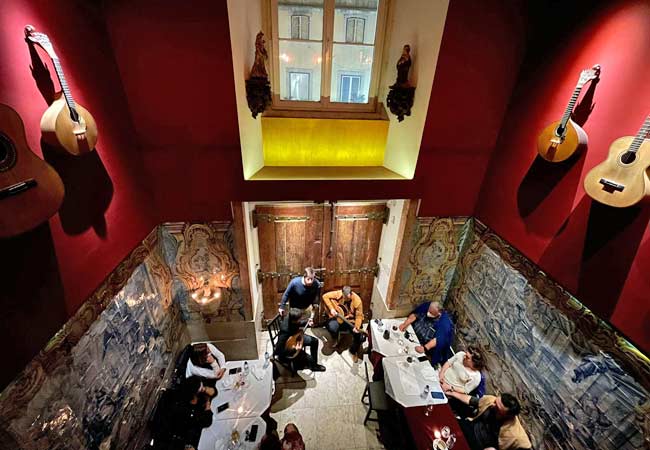
The Mesa De Frades restaurant is Alfama's most atmospheric setting for a Fado performance, and was converted from a chapel.
Castelo de Sao Jorge – This ancient castle of Lisbon stands at the highest point of Alfama. From its battlements are wonderful views over the city, while at its centre is a heavily fortified keep from which early Portuguese kings ruled (a guide to the Castelo de São Jorge).
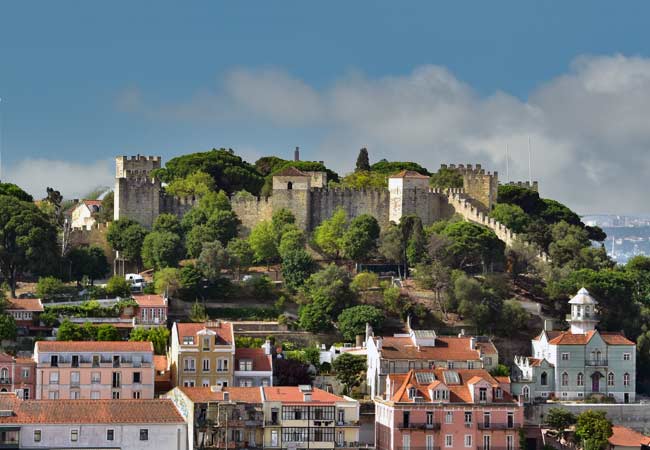
The number 28 tram route – This famous tram route of Lisbon, with its delightful 1930s yellow 'Remodelado' trams, navigates the narrow streets and hills of Alfama (a guide to the 28 tram).
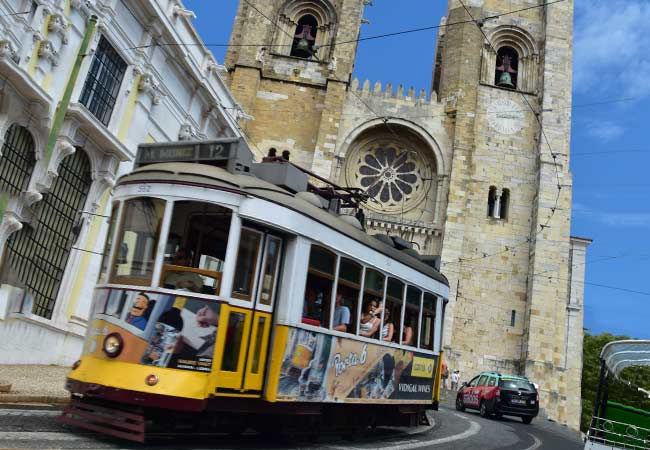
Miradouro de Santa Luzia – Hidden behind the Santa Luzia church, this pretty garden provides some of the finest views over Alfama and the Tejo Estuary
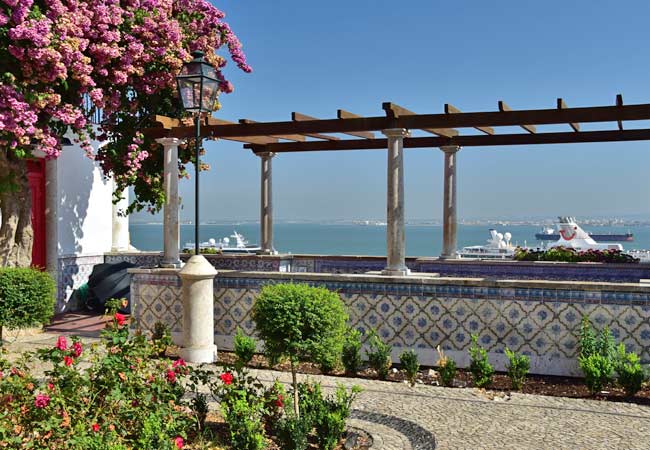
A tour of Alfama
Alfama is an amazing district to just wander and get lost in, but this approach means it can be easy to miss the main sights.
The following map is our suggested tour of the Alfama district, which will take 3 or 4 hours to complete. The yellow line is an optional route to the Graça district and the Graça viewpoint, however this requires a walk up a very steep hill. (Note: Zoom in or out to see all of the points)
Sights along the route: 1) Santo António Church 2) Lisbon Cathedral 3) Roman Theatre (ruins) 4) Santa Luzia view point 5) Lisbon Castle 6) Portas do Sol plaza 7) Museu do Fado 8) Rua dos Remédios (shopping street) 9) Panteão Nacional 10) São Vicente de Fora church 11) Graça Plaza 12) Miradouro da Graça viewpoint 13) Graça convent 14) Arco de Jesus 15) Casa dos Bicos 16) Largo José Saramago
The challenges of exploring Alfama…
Alfama extends over a steep hill rising from the banks of the Tejo Estuary to the castle, and a second hill that leads up to the Graça district.
With very few flat areas in the district, exploring Alfama means you'll be climbing steep paths and endless staircases. Combined with the hills are cobbled streets, narrow footpaths and roads that are unsuitable for traffic. This can make exploring Alfama physically demanding, especially in the heat of summer.
Insider tip: To reduce the amount of uphill walking, catch the number 12 or 28 tram up to the Largo da Graça (11) and then walk downhill through Alfama.
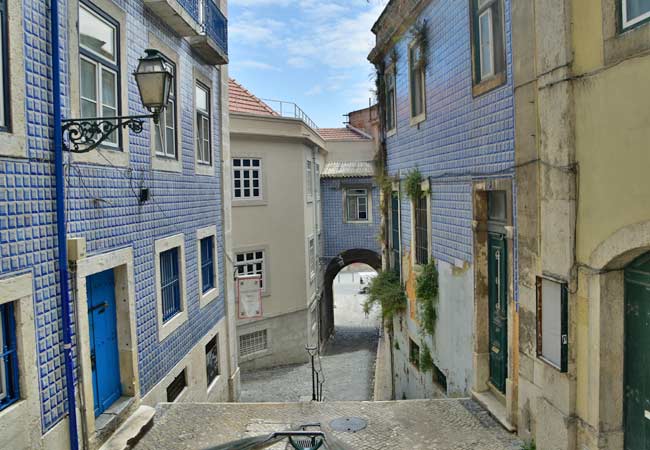
While wandering in Alfama, expect to climb lots of steps – this is the side street leading to the Arco de Jesus
During a day trip to Alfama, it's incredibly easy to get lost in the many twisting back streets - especially between the Portas do Sol (6) and the Largo do Chafariz de Dentro (7). If you truly get lost, always head downhill as this will lead to the Tejo waterfront.
There is very little public transport in Alfama, except for the number 12 tram or 28 tram, which both follow the same route. The trams can be very crowded during the day, so please be extremely cautious with valuables as they are notorious for skilled pickpockets.
The metro stations serving Alfama (Terreiro do Paço and Santa Apolónia) are poorly positioned for exploring the area, with both being situated on the extreme edges of the district. As they are on the waterfront, you will be walking uphill from them.
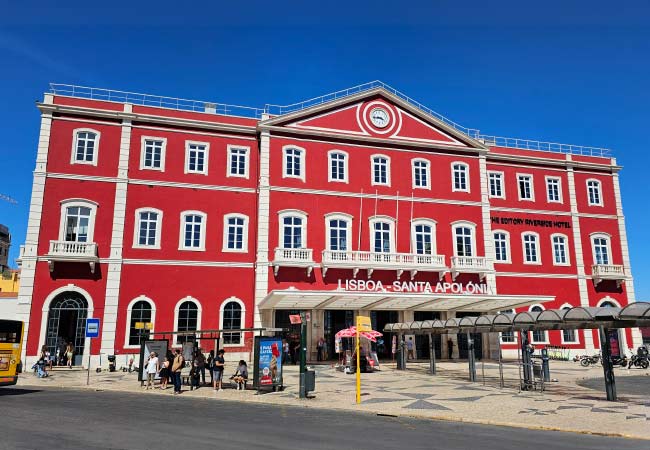
Santa Apolónia metro station is below the Santa Apolónia train station – the main intercity train station of Lisbon
How much is a day trip to Alfama going to cost?
Alfama can be an inexpensive day trip if you choose to wander the district, enter the free religious buildings and admire the viewpoints. Entrance fees and costs are:
• A ride on the number 28 tram – €3.00
• Lisbon Castle entrance fee – €10.00
• Se Cathedral entrance fee – Free
• Se cloisters and treasury - €3.00
• Museu de Santo António - €3.00
• Roman Amphitheatre – Free
• Museu de Teatro Romano - €3.00
• National Pantheon - €4.00
• Fado Museum - €5.00
• Metro single ticket – €1.80
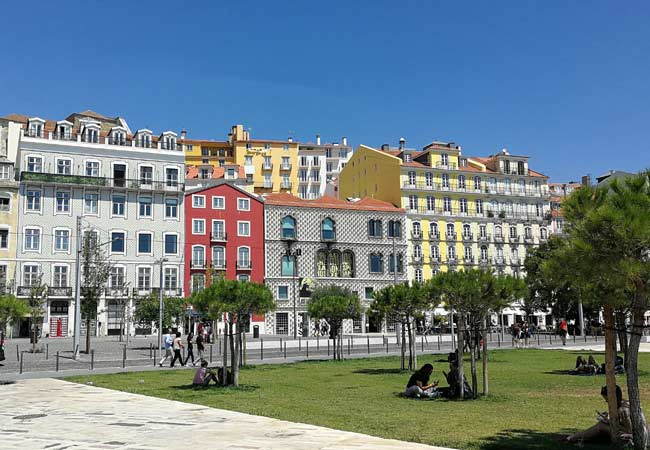
The Largo José Saramago plaza sits next to the Tejo Estuary waterfront
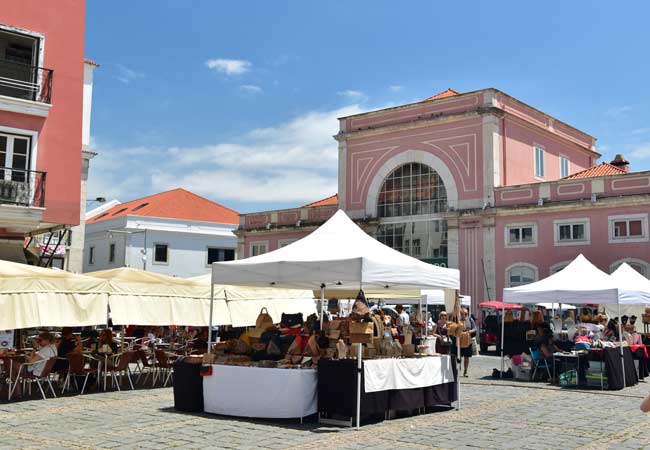
A craft market held on the Largo do Chafariz de Dentro, with the pink Museu do Fado to the rear
A stay in Alfama
Alfama is a popular and characterful district, and is an ideal base for your holiday to Lisbon. This historically dense residential area has seen many of its traditional houses being converted into charming rental apartments and small personable hotels.
Alfama is within the main tourist area of Lisbon and within easy walking distance of the Baixa district and the nightlife area of Bairro Alto. Do note the word walk, as the lack of public transport and narrow roads means you will be doing a lot of walking unless you are close to either metro station.
Related articles: Where to stay in Lisbon?
The map below shows the best accommodation and hotels to be found within the Alfama district. If you adjust it to suit your holiday dates, it will show the latest prices and availability:
Alfama's best viewpoints
With so many hills in Alfama, there are a number of fantastic viewpoints from which you can enjoy the stunning scenery.
The most famous is the Miradouro das Portas do Sol. This overlooks the patchwork of orange roofs and whitewashed houses extending down to the modern cruise terminal, where huge cruise ships can be seen towering over the waterfront. This is one of the most popular viewpoints in Lisbon and is on the main tourist route that follows the 28 tram past the Se Cathedral.
The Miradouro de Santa Luzia provides the same amazing view as the Portas do Sol, but it is less hectic. It is situated behind the Igreja de Santa Luzia church, and has the added bonus of being set within a pretty garden.
The Miradouro da Graça lies on the edge of the Graça district and provides stunning views across the Baixa district and the Castelo de São Jorge. It is a very steep walk up to the viewpoint, but at the top you will find a popular kiosk and evening hangout. Further uphill is the Miradouro da Senhora do Monte. This is the finest viewpoint of Lisbon, but it is a long and challenging walk from Alfama.
You will also find outstanding views from the battlements of Lisbon castle, a viewpoint known as the Miradouro do Castelo de São Jorge. The roof of the Panteão Nacional provides panoramic views over eastern Lisbon and the Tejo Estuary, but unfortunately not of Lisbon's historic centre.

The Miradouro das Portas do Sol
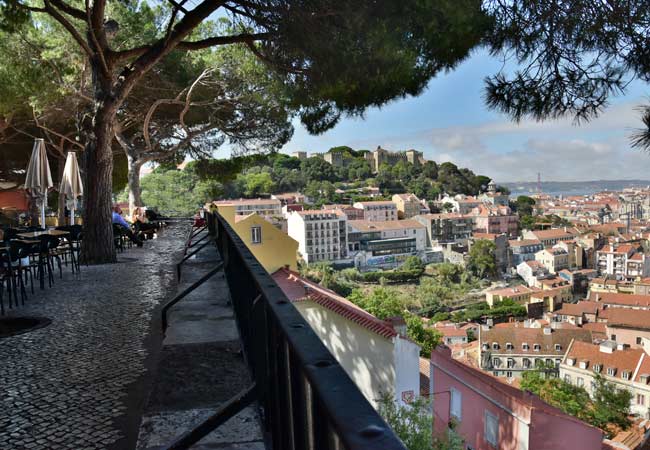
The Miradouro da Graça
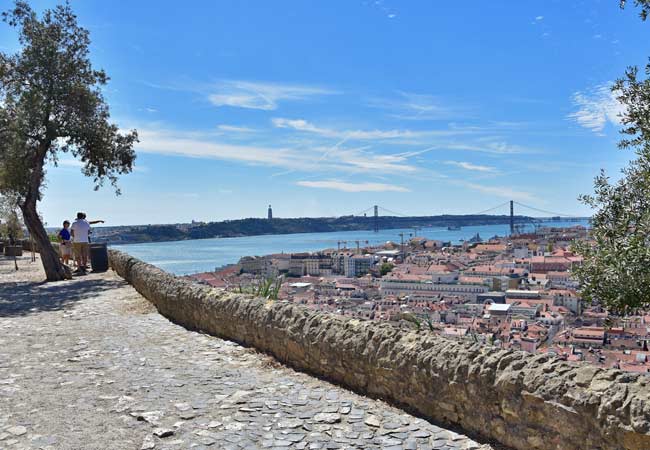
The Miradouro do Castelo de São Jorge
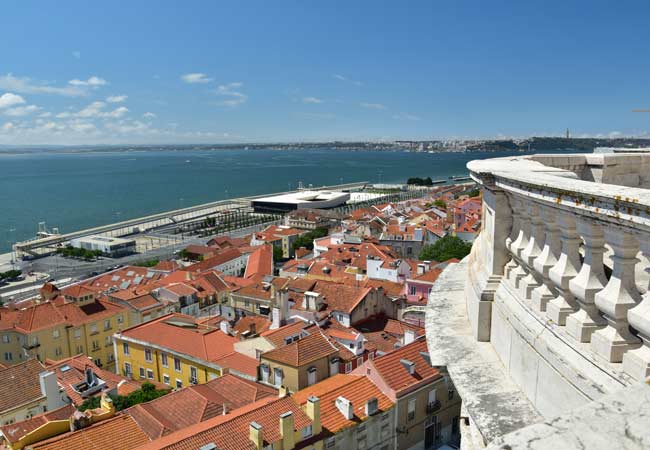
The view from the roof of the Panteão Nacional
Alfama nightlife
Alfama nightlife could be considered as a much calmer version of the Bairro Alto district, which consists mostly of late-night restaurants and bars. Most bars in Alfama are small, often having just a handful of tables, and this gives them a personable and intimate atmosphere. Alfama is not for wild nights, it’s a place to chat and socialise with friends.
On the waterfront of Alfama, you will find 'Lux-Frágil' Lisbon's oldest superclub. The club can be notoriously fussy about who they let in, and will set a deterrent entrance fee of €300 if they don't want you to enter. The nightclubs around Pink Street are much more diverse and tourist-friendly.
Is Alfama safe?
Alfama is generally a safe area of Lisbon, but common sense should be used, especially late at night. The biggest risk to most tourists are the pickpockets who operate on the packed trams.
Alfama is significantly safer for visitors than it was 10 years ago, due to the increase in tourism and foreign investment. However, this has come at the price of the community atmosphere, with locals struggling to afford to live here.
Why is Alfama the oldest section of Lisbon?
While the majority of Lisbon was destroyed by an earthquake in 1755 and later rebuilt, much of Alfama survived. The district sits on a solid rock hill that shocked less during the event, and the district's elevation meant it escaped flooding caused by the following tsunami.
As such, the streets of Alfama still follow the original medieval layout of the city, which has barely altered since its foundation.
The best sight in Alfama - Lisbon castle
The best tourist attraction of the Alfama district is the Castelo de São Jorge. This castle has been entwined with Portugal’s early history and was the location in which the Christian Crusaders defeated the North African Moors in 1147. The castle’s importance waned from the 15th century and was badly damaged by the 1755 earthquake, but was restored to its former magnificence in the 1940s.
For your visit, there is a lot to see in the castle, including the fortified keep, a museum and views from the battlements. A typical visit lasts 1hour, and the adult entrance fee is €10.
Related articles: Guide to Lisbon castle
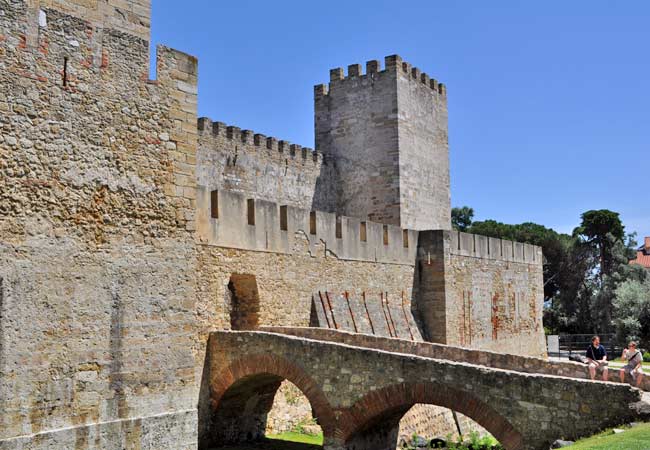
The main keep of the castle
Alfama’s best activity – riding the no. 28 tram
The most enjoyable activity of Alfama, is a ride on the number 28 tram. This tram route connects the districts of Graça with Estrela, but the most scenic section is as it passes through Alfama. This narrow and undulating tram route is totally unsuitable for any modern trams, so the historic Remodelado trams, which date from the 1930s, provide the service instead.
Related articles: The 28 tram
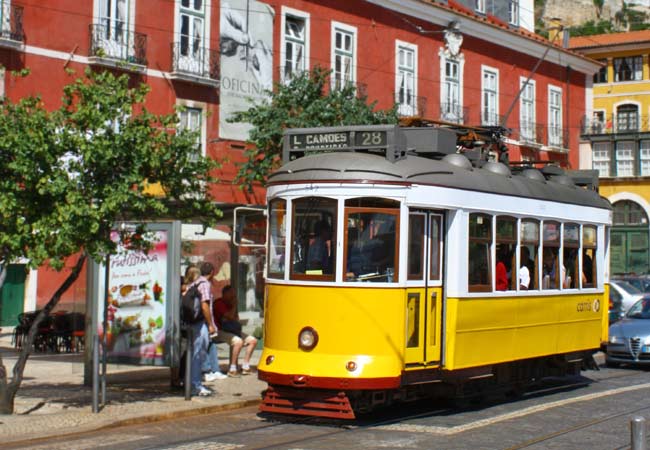
The E28 as it passes through the Largo das Portas do Sol
Main Tourist Sights of Alfama
The Se Cathedral
The Sé de Lisboa is the solid and imposing cathedral that dates from the 12th century. The cathedral is a blend of Gothic and Romanesque styles and its interior is very austere when compared to the extravagance of the Mosteiro dos Jerónimos or numerous baroque churches in Lisbon.
The cathedral was constructed on the site of a major mosque and excavations of this original structure can be seen in gothic cloisters to the rear of the cathedral.
Related articles: The Se cathedral
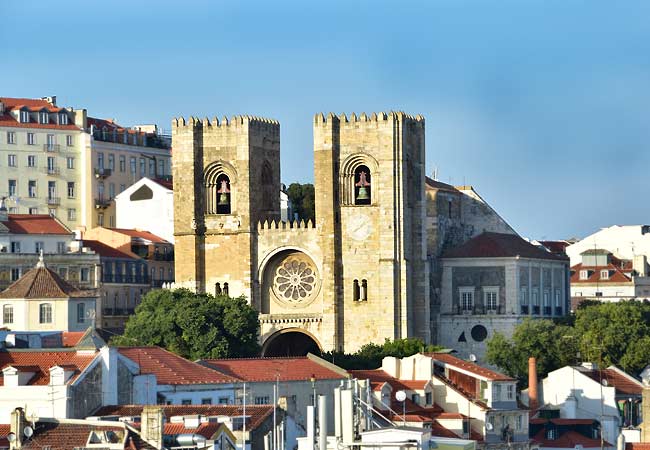
The magnificent Se Cathedral
Igreja de Santo António de Lisboa
Saint Anthony is the patron saint of Lisbon, and the church dedicated to him was constructed on his birthplace.
Saint Anthony was born in 1195 but the Baroque-Rococo styled church dates from 1767, as the original church was destroyed by the devasting 1755 earthquake.
Related articles: Igreja de Santo António de Lisboa
The National Pantheon (Panteão Nacional)
Church of Santa Engrácia is the National Pantheon of Portugal, and final burial location of many important Portuguese, including the poet Luís de Camões and the explorers Vasco da Gama and Henry the Navigator.
Related articles: Panteão Nacional
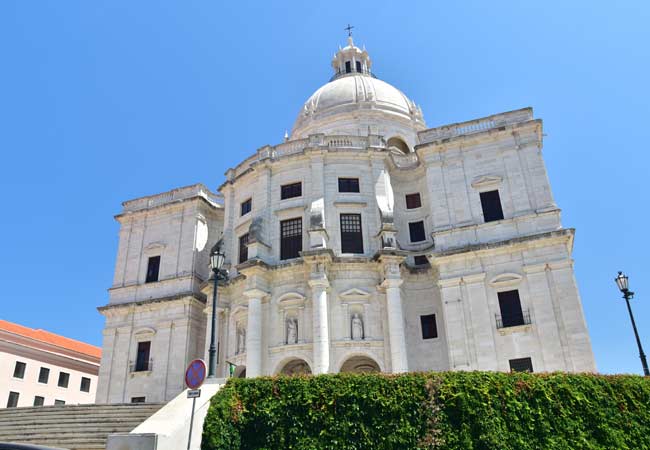
The Fado Museum
Fado is an emotional and sorrowful style of music, which originated in the tough neighbourhoods where the sailor’s families lived. Fado is sung by a solo singer and is accompanied by a traditional Portuguese guitar and this mournful yet powerful music reflects the emotions felt by sailor’s wives, who were waiting for their husbands to return. The Museu do Fado details the history of this style of music.
Related articles: Fado music
Chafariz d’El Rei
The Chafariz d’El Rei (king’s fountain) dates from the 13th century and supplied drinking water to ships moored on the banks of the Tejo. This fountain was on the outside of the city walls, while the Chafariz de Dentro (inside fountain) served the residences of Alfama and is in the Largo do Chafariz de Dentro (location 13).
Casa dos Bicos
The Casa dos Bicos (The house of spikes) was constructed by the first Viceroy of India in 1523, who took his inspiration from was inspired similar “spiked” buildings in Italy and Spain. The top two floors were destroyed by the 1755 earthquake and were only restored in 1981.
Roman Amphitheatre (Teatro Romano)
Lisbon was a major Roman city, and below the streets of Alfama are the remains of a Roman amphitheatre, which had a capacity for 5,000 spectators. Close to the amphitheatre is the Museu Teatro Romano, a small museum that displays many of the artefacts that were discovered at the site.
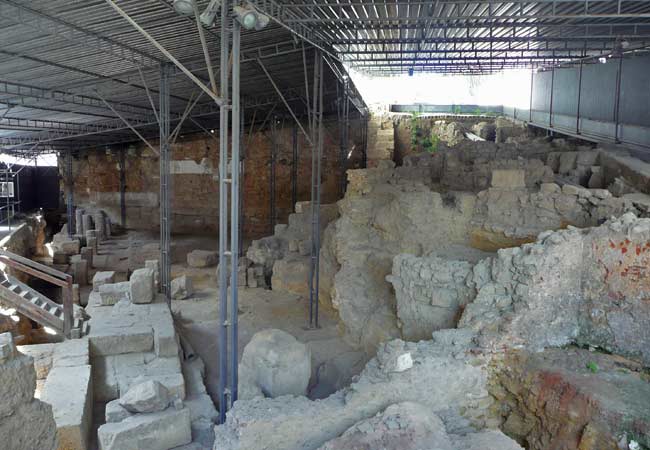
The remains of the Roman Amphitheatre in Lisbon
Discover more of Lisbon with our most popular guides
Thank you,
We really appreciate you visiting our website, but the digital world is changing for the worse.
Independent publishers like us face many new challenges. Search engines now prioritize ads over organic content, and AI replicates our hard work.
If you enjoyed our work, please bookmark our website to easily find us again or share it on social media with your friends and family.
We aim to keep our 1,600+ pages accurate and fully updated. If you spot any errors or outdated information, please contact us at: [email protected]
A complete list of all of our Lisbon articles
Please help us
The digital landscape has shifted, squeezing small publishers like us. Between search engine biases and AI plagiarism, we're feeling the heat.
All we ask is that you bookmark us for quick access and share the articles you love.
Spotted an error? Let us know - with over 1,600 pages to maintain, we always welcome your vigilance.
Please contact us at: [email protected]
































